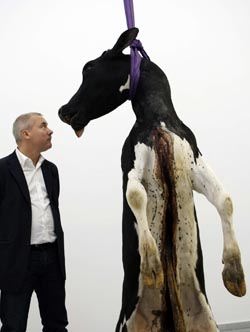“An artist in formaldehyde”
PinchukArtCenter hosts “Requiem,” the largest retrospective of the works by the British artist Damien Hirst
The horribly expensive British artist Damien Hirst first showed up in Kyiv and Ukraine in 2007. The exhibit “Reflection” in the PinchukArtCenter included his works that appeal to the eternal topic of death and the oeuvres by Jeff Koons, Antony Gormley, Andreas Gursky, and other celebrated artists of the present time.
The event was crucial for the Ukrainian artistic milieu, because nobody has every seen any presentation of contemporary art on such a scale. So, today Hirst’s works are making their second visit to the PinchukArtCenter. This time it is a one-man exhibit of the British artist, and the largest one ever at that. The exposition includes 100 works, created since the early 1990s until the present day. In addition to the works that were in Kyiv two years ago, there are 40 new pictures, in particular from his new 2006–08 cycle “Skull Paintings.” Nevertheless, the main drawing cards will be the already familiar installations: A Thousand Years (1990), Away from the Flock (1994) and Death Explained (2007). These are a shark cut into halves and placed in an tank with formaldehyde, cow’s heads, and other aesthetic delights of death.
Several elements can be distinguished in Hirst’s creative work. The first one is art as “discovery,” as the author calls it. “The constant desire of the humanity to live in the face of the inevitability of death is the theme to which the artist has turned in his works for two decades in a radical and direct form,” says the press release. The theme of death in art is not new, mildly speaking, but Hirst approached it in a graphic and patently non-philosophic way. Some perceive him as the end of art, while others — as its starting point, because artists at all times contemplated about death (although their reflections did not take the brutal form of a ripped cow’s carcass with the entrails inside out). Be as it may, Hirst is a phenomenon: first, because something in this world has prompted the emergence of such an artist and, second, because there is a huge demand for his oeuvres.
The second element is art as a money machine. As one of the most expensive modern artists, Hirst is a brand, which is metaphorically embodied by an “artist in formaldehyde” surrounded by the “joyous company” of dead sharks, skulls, skeletons, flies, and death as such.
One more aspect is art as a conveyer. Hirst maintains a whole shop of artists who implement his ideas. He does not conceal this. “He has successfully combined the seemingly incompatible artistic strategies and created a perfectly functioning system of creative production,” explained Eckhard Schneider, general director of the PinchukArtCenter.
Finally, one more aspect is art as a show, because anyone can become Hirst’s co-author. On April 25–26 the so-called “painting machines” will be installed in the courtyard of Kyiv’s Arena Complex. These contraptions will be available to anyone who wants to paint on a canvas his/her own picture using the same technique as in the artist’s newest cycle “Skull Paintings.” Hirst and his assistants will be helping in the process. If you are fortunate enough to interact with him, you may finally decide where to place his art in your worldview.
A hundred of the artist’s works have taken all the floors of the PinchukArtCenter. But the most shocking fact is that the gallery was specially rebuilt so that the artist’s works “felt” there as comfortable as possible. A special hall was constructed for certain displays (specifically, the famous sharks in formaldehyde). Besides, the PinchukArtCenter has launched the so-called educational program. First, guides will be conducting tours for groups of visitors everyday from 2 p.m. to 7 p.m. Second, an information center of the gallery will be established to help learn about all the exhibits, read interviews and articles on them, and see photos. Third, the gallery will open a library with specialized literature, art publications, and catalogues.
The exhibit “Requiem,” which will continue until September 20, is, as usual, free for all visitors, and will be open everyday, except for Monday, 12 a.m. — 9 p.m.






